 Portrait of Juan De Pareja.
Portrait of Juan De Pareja.
1650, Diego Velázquez paints De Pareja, a slave who assists in his workshop, during an extended visit to Rome. Later the same year, Velázquez grants De Pareja a letter of freedom which goes into effect on their return to Madrid four years later.
De Pareja, born into slavery in Antequera, Málaga province, around 1606, works as an independent painter in Madrid until his death in 1670. His Calling of St. Matthew (1661) is on display at the Museo del Prado.
Velázquez’s portrait of De Pareja is in New York’s Metropolitan Museum of Art.
1650, African slaves arrive to work new sugar plantations established by French Gov. Charles Houël du Petit Pré. Slaves quickly turn to mass desertion and, in 1656, to a two-month uprising. Slaves are aided by the few remaining Carib people in the mountains.
European colonization of Guadeloupe began late, because Carib repelled Spanish and French for 120 years. The Indians were undermined mainly by disease beginning in 1635; most ultimately fled to Dominica.
1650, British build slave factory at Whydah on Slave Coast (now Benin). The dominant Dahomey kingdom forges into the interior, capturing many thousands through tribal wars and selling them to Europeans and Arabs. By 1716, Whydah is the second-busiest African factory in Britain’s triangular trade.
Vodou (or voodoo) arose in region north of Whydah, which is considered the capital of vodou today.
1651, Thousands of Scots, prisoners after Cromwell’s Sept. 3 victory at Worcester, are forced into servitude, for up to 10 years, and sent to Virginia and Barbados. Some Barbadian plantations count 50 such indentured servants for every 100 slaves.
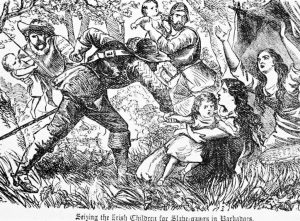 Irish captured for Slave trade.
Irish captured for Slave trade.
1652, Catholic landed gentry and officers lose estates to victorious Parliamentarian supporters, clergy (blamed for 1641 uprising) are killed or banished, thousands of officers and soldiers are transplanted to Spain, 40,000 peasants are pushed into Connaught and perhaps 10,000 more, including homeless women and 2,000 adolescent boys and girls, are shipped to colonies in America, especially Barbados.
Caribbean Irish: Last of the forced indentured servants on Barbados are said to be freed by 1680. Many freed Irish move on to Jamaica and Montserrat, some becoming planters and slave masters. Others stay to create the Barbadian “Redlegs” community that maintained its Irishness into the 21st century.
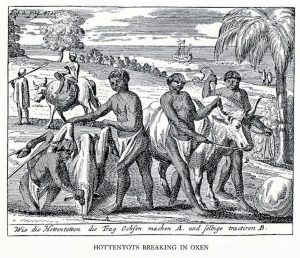 Khoikhoi people with cattle.
Khoikhoi people with cattle.
1652, Dutch East India Company establishes trading and naval supply station at the Cape of Good Hope, as refuge for ships sailing to India and the Far East. Within 30 years several thousand colonists settle here, most of them former company soldiers and sailors.
The native Khoikhoi people, nomads with cattle, are decimated by European-introduced smallpox and are slowly pushed to the north.
Slaves are introduced by Dutch from Madagascar, Mozambique and even from South and Southeast Asia to work on grain, wine, pastoral farms (few large plantations develop).
This is the second European colony to be established on sub-Sahara mainland, as opposed to the fort-factories. First was Angola by Portugal, 1575.
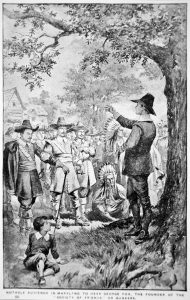 George Fox preaches his ideas to the Quakers.
George Fox preaches his ideas to the Quakers.
1652, George Fox climbs Pendle Hill in Lancashire where he envisions many souls coming directly to Christ, without interference of clergy. He is developing ideas and methods of the Religious Society of Friends—mocked by a judge as “the Quakers.”
Fox visits Barbados, Jamaica and Maryland in 1671. While there is no record of any statement on slavery, hostile Barbadian planters say his words might incite a slave rebellion.
1652-1654, Under Cromwell, Britain’s fierce competition with the Netherlands and its dominant merchant fleet leads to first of three Anglo-Dutch wars, which ends inconclusively after the two sides trade naval victories.
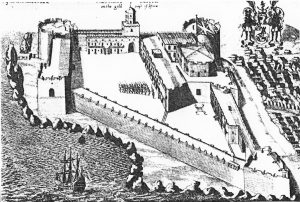 Cape Coast Castle.
Cape Coast Castle.
1653, Swedish Africa Company builds a new Cape Coast Castle on Gold Coast under Hendrik Caerloff, but Dutch soon take it over. Europeans trade for slaves with Guan people’s Fetu Kingdom.
1654, Dutch, who lose last toehold in Brazil this year, establish a new and successful slave market on Curaçao. Enslaved Africans brought here from Elmina and other West Africa factories are then sold on Willemstad docks before delivery to their final destination on the Spanish Main or in the Caribbean.
1655, At Cromwell’s direction, Gen. Robert Venebles and William Penn (father of Pennsylvania’s founder) lead an attack on Santo Domingo, April 13, which is thwarted by Spanish in two weeks.
British fleet then turns to Jamaica, quickly overcoming light garrison to take Santiago de la Vega (Spanish Town). This begins long British struggle with Spanish settlers and slaves they freed (or who escaped) who establish Maroon communities in the mountains. Within a year, British lose most of their men to disease.
It isn’t until 1660, when a British governor persuades Maroon leader Juan de Bolas to switch sides, that Spanish give up and flee to Cuba.
British governors also encourage pirates, who control Port Royal, to attack Spanish ships as well as cities on the Spanish Main and throughout Caribbean.
Jamaica will succeed Barbados as Britain’s main slave-worked sugar plantation holding.
1656, Dutch West India Company signs Treaty of Butre with the Ahanta people who basically accept protectorate status and a new Fort Batenstein. The treaty with Ahanta (supplanted eventually by Ashanti), will stand until the Netherlands sells its Gold Coast holdings to British in 1872, one of the longest-lasting agreements between European and African peoples.
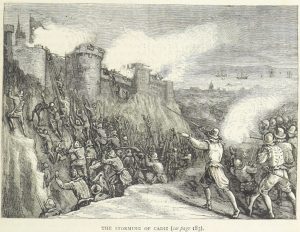 British invading Santa Cruz Bay.
British invading Santa Cruz Bay.
1657, Robert Blake’s British fleet breaks off blockade of Cádiz to burn a 17-ship Spanish silver convoy in Santa Cruz Bay, Tenerife, April 20. Blake loses no ships, but misses the silver which, previously unloaded, is safe ashore.
1659, Spain concedes control of lightly populated northwest Hispaniola to French pirates, who name it Saint-Domingue; Louis XIV formally approves a settlement on Tortuga. Pirates here are persuaded to give way to agriculture, especially sugar and coffee plantations worked by slaves.
To meet demand, France also builds a new African slave factory on Île Saint-Louis (Ndar) near mouth of Senegal river, replacing its 1638 fort on Bocos Island to the north.
French version of Triangular Trade sees slave ships sail first from Le Havre, and later from Nantes, Bordeaux and La Rochelle.
1659, British East India Company builds fort to establish colony on lonely volcanic island of St. Helena, a haven for ships plying South Atlantic. Company wins a royal charter, but attracts few settlers.
1660, Newly restored to the crown, May 29, Charles II charters Company of Royal Adventurers. Company is led by Charles’s brother, James, the duke of York. First goal is to trade for gold, but new charter in 1663 directs company to supplant Dutch as main provider of African slaves to British-colony plantations.
Note: Charles and James intensely promote and personally profit from slave trade, with Charles appointing colonial governors of Carolina who offer settlers 50 acres of land for each slave or servant bought.
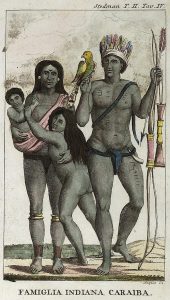 Family of Caribs.
Family of Caribs.
1660, British and French said to agree not to settle Dominica or St. Vincent, fiercely defended by indigenous Carib who have repelled European visitors for more than 150 years.
Both become havens for slaves escaping from nearby Guadaloupe, Martinique, St. Lucia and even Barbados.
Africans who escape to St. Vincent intermarry with Caribs, leading to a mixed Black Carib population and a smaller Yellow Carib community. The Black Caribs will fight many battles in the 18th century against would-be masters, usually British, and are never enslaved.
1661, Barbados assembly adopts first comprehensive slave code for British colonies, which is copied by Jamaica (1664), South Carolina (1696) and Antigua (1702). Virginia and Maryland codes are also influenced.
Prescribes whipping for those who hurt Christians (first offense), and nose-slitting and face-branding (second offense), with no right to trial. And if a slave is injured or dies under punishment by master, “...no person whatsoever shall be liable to any fine...”
1661, Company of Royal Adventurers seizes island and fort in Gambia river from Dutch. Renamed James Island (for Charles II’s brother and the Royal Adventurers’ leader), it becomes an important center for the company’s West Africa slave trade.
1662, Virginia court rules that children born of mixed relationship will hold the status of their mother, usually black and a slave, and will be the property of mother’s master, invariably white. Applying the Barbados code.
1662, Catarina, daughter of Portugal’s João IV, marries Charles II of Britain, cementing alliance against Spain. Her dowry includes Tangier and islands of Bombay, but apparently none of Portugal’s African slave factories.
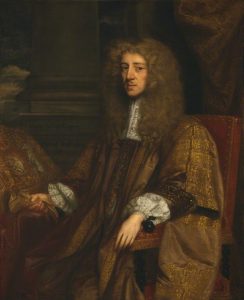 King Charles II.
King Charles II.
1663, Charles II grants charter establishing the Carolina colony to eight noblemen critical to his regaining the British throne, March 24. These proprietors, who name the colony for the king, include Anthony Ashley Cooper, Earl of Shaftesbury, who assigns his secretary, John Locke, to help draft a “Grand Model” for the colony.
1663, This year through 1731, the Company of Royal Adventurers (which morphs into the Royal African Company in 1672) embarks approximately 212,000 slaves, or more than 3,000 annually, bound mainly for Caribbean plantations but also for North American colonies. Of the total, 44,000 die en route.
To signify good health, many slaves are branded “DoY,” for Duke of York. That ends by 1685 when Charles II dies and his brother, the duke, ascends throne as James II.
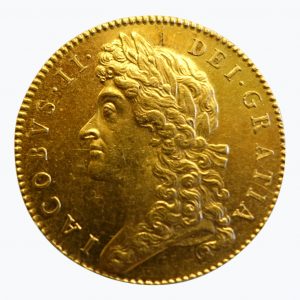 First "guinea" coin.
First "guinea" coin.
1663, First “guinea” is minted, one inch in diameter, of 0.92% pure gold, with Charles II on the obverse side, Feb. 6. Its worth, originally one pound (20 shillings), fluctuates with price of gold, most of which comes from the Company of Royal Adventurers’ Gold Coast trading operations. Full guineas are produced through 1799.
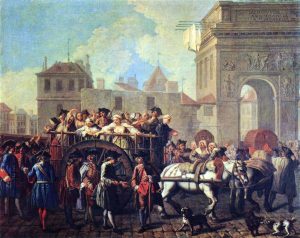 Young women from France are taken to Quebec.
Young women from France are taken to Quebec.
1663, To persuade soldiers and skilled workers to make a life in New France, Louis XIV and advisor Jean-Baptiste Colbert begin a 10-year program to recruit marriageable women to sail to Québec. Most of the more than 830 filles du roi are 19-29 years old, and from Paris (including orphans) or Normandy (including experienced farm girls). All are endorsed by parish priests, and receive a hope chest and dowries of at least 50 livres in gold.
Upon arrival, most marry quickly and collectively bear hundreds of children, helping to double the population to 6,700 by 1672. Two-thirds of today’s French Canadians trace ancestry back to at least one fille du roi
1664, Sailing on behalf of the Company of Royal Adventurers, a British fleet under Robert Holmes seizes most Dutch factories on African West Coast, including Cape Coast Castle and Gorée Island (at Cape Verde), as well as several Dutch ships (including West India Company’s Goulden Lyon).
Dutch Adm. Michiel de Ruyter takes back all African factories later in year, except Cape Coast, which Britain holds well into the 20th century.
Also in 1664, British seize New Amsterdam with four ships and 450 men. Peter Stuyvesant is forced by his reluctant burghers to capitulate without a fight, Sept. 6, and retires to his “Bowery” farm. British rename the town New York, for James, the duke of York.
These preliminaries lead to second of three Anglo-Dutch wars. Which in turn leads to the brief collapse of the Company of Royal Adventurers, 1667.
1664, Spain offers land on Puerto Rico to lure free people of color living on Jamaica, in Saint-Domingue and in other non-Spanish territories. They settle in western and southern regions. Most are mixed-race and adapt Spanish customs; some join the militia.
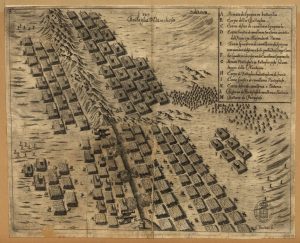 1665, Portuguese, with British allies, defeat Spanish invaders in the Battle of Montes Claros, in the Alentejo near the mutual border, June 17. Spain suffers 7,000 dead, 4,000 wounded and 6,000 prisoners in this decisive end to fighting in war over Portuguese Restoration.
1665, Portuguese, with British allies, defeat Spanish invaders in the Battle of Montes Claros, in the Alentejo near the mutual border, June 17. Spain suffers 7,000 dead, 4,000 wounded and 6,000 prisoners in this decisive end to fighting in war over Portuguese Restoration.
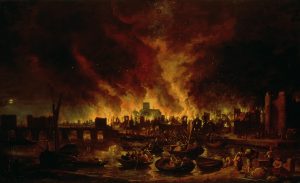 The Great Fire ravages London.
The Great Fire ravages London.
1665, Bubonic plague breaks out in spring, kills more than 100,000 of London’s half-million residents and spreads beyond. Then the Great Fire destroys 80 percent of the city’s structures, Sept. 2-6, 1666.
 The Dutch launch attack against British on Thames river.
The Dutch launch attack against British on Thames river.
1667, Audacious Dutch naval raid into the Thames estuary and up the Medway burns or captures 14 major ships over five days, including the British flagship, HMS Royal Charles, which is taken back to the Netherlands, June. Fleet of 62 ships is led by Adms. Willem Joseph van Ghent and Michiel de Ruyter.
This, one of the Royal Navy’s worst disasters ever, forces Charles II to end the second Anglo-Dutch war (to curb British anger with their king) without achieving trade goals, which include taking over Dutch slave trade. The British fare no better in the third Anglo-Dutch war, 1672-1674.
British keep New York; Dutch keep Surinam, where Britain established slave-worked plantations in 1630. Dutch took it by force in February 1667.
1668, First outbreak of yellow fever in Britain’s North American colonies occurs in New York.
1669, A proposed constitution for Carolina, which asserts that “every freeman of Carolina shall have absolute power and authority over his negro slaves,” is transcribed by the Lord Proprietors’ secretary, John Locke (but written by others). Locke is rewarded with Company of Royal Adventurers stock.
This constitution is never ratified.
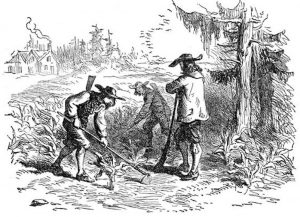
First settlers arrive in Charles Town.
1670, First Carolina settlers, landholders from Bermuda led by William Sayle, found original Charles Town. It will be the first planned community in the English colonies, following the “Grand Model” set forth by Locke. The plan applies lessons of public health and safety learned from the Great Fire of London.
A year later, John Yeamans arrives with about 200 African slaves.
1670, British possession of Jamaica (dating back to 1655) is confirmed by Treaty of Madrid. Large Irish community also noted, originally brought in as indentured servants and soldiers, or as political prisoners (from Cromwell’s invasion of Ireland).
1670, Osei Tutu, king of the Ashanti, an Akan people, establishes a Gold Coast empire straddling Volta river west of the Oyo Empire. Kumasi is its capital.
When they are strong and have captives to sell, the Ashanti favor the Dutch factories. When they are weak, many captive Ashanti are forced onto ships at Elmina, Cape Coast Castle and other European factories.
Ashanti descendants are found widely in Jamaica, Barbados, the Virgin Islands and the Netherlands Antilles.
1672, Charles II charters a new Royal African Company in place of the collapsed Company of Royal Adventurers, with exclusive authorization to buy gold and captives in Africa. Charles’s brother, James, continues as its governor.
Bunce Island slave factory established in Sierra Leone estuary.
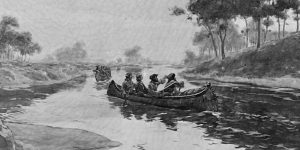 Joillet, Marquette and French Canadians voyageurs sail down Mississippi river.
Joillet, Marquette and French Canadians voyageurs sail down Mississippi river.
1673, Louis Jolliet, Jacques Marquette (a Jesuit priest) and five voyageurs descend the Mississippi in two canoes, from the Wisconsin river to the mouth of the Arkansas river, the first European expedition to do so. They turn back, 435 miles short of the Gulf of Mexico, to avoid possible conflict with Spanish adventurers.
Indians show them two critical portages, between the Fox and Wisconsin rivers, and between the present Des Plaines and Chicago rivers; the latter on their return trip to Lake Michigan.
